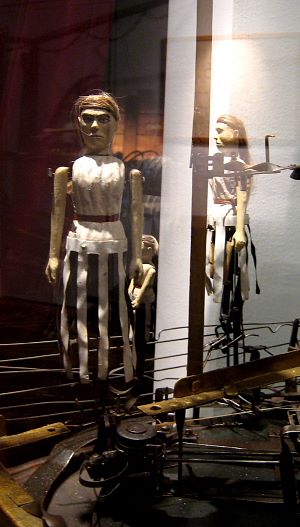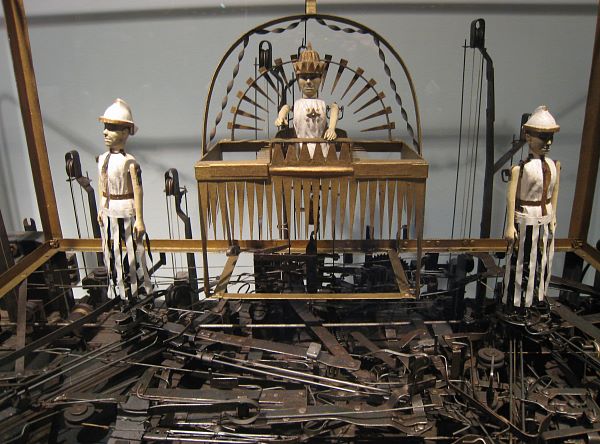The Solomon's Judgment machine.
Leeuwarden, Netherlands
 Last May I went to the Exposure '08 event in Leeuwarden in the northern Netherlands, and then I went to GAmeland in September. Both were courtesy of the Northern College of Leeuwarden. Now I've started work for the NHL, as it's known, on a regular basis. For the next little while, I'll be consulting for the college and working with the students on quite a number of projects.
Last May I went to the Exposure '08 event in Leeuwarden in the northern Netherlands, and then I went to GAmeland in September. Both were courtesy of the Northern College of Leeuwarden. Now I've started work for the NHL, as it's known, on a regular basis. For the next little while, I'll be consulting for the college and working with the students on quite a number of projects.
One of the projects I'll be involved with concerns an extraordinary machine built in the early 1900s. Beginning in the Renaissance, German clockmakers began creating wonderful mechanical devices that acted out stories from the Bible using puppets. In the early 1900s, a young Dutchman named Jan Elzinga decided to build one himself -- all by himself. And he did. It's called "Solomon's Judgment," and it tells the Biblical story, in mime, of how Solomon was required to decide which of two women was the true mother of a child. (You can find the story in 1 Kings 3:16-28, if you don't know it.)
 Elzinga was a mechanical genius, but he was poor. He lived alone with his mother, had no job, and had to scrounge parts wherever he could find them -- mostly from the blacksmith's forge and the bicycle shop. He shut himself in his room, and for three years, he worked on his amazing invention. When it was done, it was one of the wonders of the Netherlands, and it was put on display all over the country. Originally it had to be cranked by hand, and it ran for 35 minutes continuously. To reset it, it has to be cranked backwards for 35 minutes!
Elzinga was a mechanical genius, but he was poor. He lived alone with his mother, had no job, and had to scrounge parts wherever he could find them -- mostly from the blacksmith's forge and the bicycle shop. He shut himself in his room, and for three years, he worked on his amazing invention. When it was done, it was one of the wonders of the Netherlands, and it was put on display all over the country. Originally it had to be cranked by hand, and it ran for 35 minutes continuously. To reset it, it has to be cranked backwards for 35 minutes!
Sometime in the 1930s, though, the machine was damaged in shipment, and was not repaired. Jan Elzinga died in 1947, and when he went, the secret of the machine went with him. He never made any plans -- they were all in his own head. Two mechanical engineers tried to restore the machine in the 1970s, mostly during their spare time. They made a lot of notes, but even they never fully understood it.
This is where I get involved. The Solomon's Judgment machine now sits, broken, in the Martena Museum in the the town of Franeker. The museum doesn't want to try to repair it, but they have some money to make a virtual 3D model of the machine, and a video game that incorporates the machine as one element. The game design students at NHL are designing the game, and the 3D students are doing the modeling. As you can see from the pictures, it's a huge task. The model will enable us to make an animation of the machine in operation -- the first time that anyone has seen it (or rather, its virtual equivalent) working in over 30 years. My job is to advise the students on the game. When we're done, it will run on a kiosk in the museum, and perhaps on the museum's web site also.
I find this incredibly exciting. I love old technology, especially mechanical things, and you don't often get a chance to work on something like this. Although it's thousands of years younger and its purpose is known, it sort of reminds me of the Antikythera Mechanism -- a mysterious machine whose workings are not well understood.

 Last May I went to the Exposure '08 event in Leeuwarden in the northern Netherlands, and then I went to GAmeland in September. Both were courtesy of the Northern College of Leeuwarden. Now I've started work for the NHL, as it's known, on a regular basis. For the next little while, I'll be consulting for the college and working with the students on quite a number of projects.
Last May I went to the Exposure '08 event in Leeuwarden in the northern Netherlands, and then I went to GAmeland in September. Both were courtesy of the Northern College of Leeuwarden. Now I've started work for the NHL, as it's known, on a regular basis. For the next little while, I'll be consulting for the college and working with the students on quite a number of projects.One of the projects I'll be involved with concerns an extraordinary machine built in the early 1900s. Beginning in the Renaissance, German clockmakers began creating wonderful mechanical devices that acted out stories from the Bible using puppets. In the early 1900s, a young Dutchman named Jan Elzinga decided to build one himself -- all by himself. And he did. It's called "Solomon's Judgment," and it tells the Biblical story, in mime, of how Solomon was required to decide which of two women was the true mother of a child. (You can find the story in 1 Kings 3:16-28, if you don't know it.)
 Elzinga was a mechanical genius, but he was poor. He lived alone with his mother, had no job, and had to scrounge parts wherever he could find them -- mostly from the blacksmith's forge and the bicycle shop. He shut himself in his room, and for three years, he worked on his amazing invention. When it was done, it was one of the wonders of the Netherlands, and it was put on display all over the country. Originally it had to be cranked by hand, and it ran for 35 minutes continuously. To reset it, it has to be cranked backwards for 35 minutes!
Elzinga was a mechanical genius, but he was poor. He lived alone with his mother, had no job, and had to scrounge parts wherever he could find them -- mostly from the blacksmith's forge and the bicycle shop. He shut himself in his room, and for three years, he worked on his amazing invention. When it was done, it was one of the wonders of the Netherlands, and it was put on display all over the country. Originally it had to be cranked by hand, and it ran for 35 minutes continuously. To reset it, it has to be cranked backwards for 35 minutes!Sometime in the 1930s, though, the machine was damaged in shipment, and was not repaired. Jan Elzinga died in 1947, and when he went, the secret of the machine went with him. He never made any plans -- they were all in his own head. Two mechanical engineers tried to restore the machine in the 1970s, mostly during their spare time. They made a lot of notes, but even they never fully understood it.
This is where I get involved. The Solomon's Judgment machine now sits, broken, in the Martena Museum in the the town of Franeker. The museum doesn't want to try to repair it, but they have some money to make a virtual 3D model of the machine, and a video game that incorporates the machine as one element. The game design students at NHL are designing the game, and the 3D students are doing the modeling. As you can see from the pictures, it's a huge task. The model will enable us to make an animation of the machine in operation -- the first time that anyone has seen it (or rather, its virtual equivalent) working in over 30 years. My job is to advise the students on the game. When we're done, it will run on a kiosk in the museum, and perhaps on the museum's web site also.
I find this incredibly exciting. I love old technology, especially mechanical things, and you don't often get a chance to work on something like this. Although it's thousands of years younger and its purpose is known, it sort of reminds me of the Antikythera Mechanism -- a mysterious machine whose workings are not well understood.



<< Home